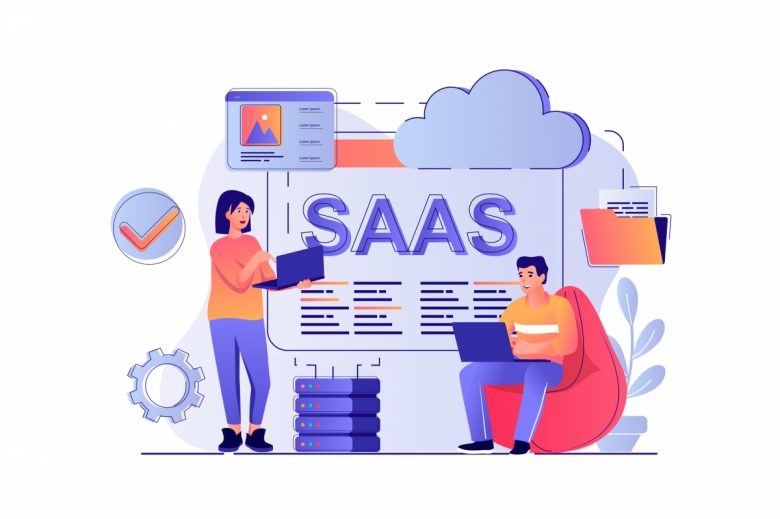As technology advances, so too do company practices where automation is the evident next step in the evolution of the world of work. This prospect may make the current labor force insecure about their place in the future where it might help, instead, to focus on the opportunities that the 4th industrial revolution presents. Such opportunities include learning new skills required for innovation such as digital literacy.
In this article, we are looking at SaaS companies in more detail. We will also look at the benefits of this model for the user and the SaaS company itself. This will better help you understand if this is a business model worth pursuing. By the end of this article, you will also know what it means to use SaaS companies for your business.
What is a SaaS Company?
Short for Software as a Service, SaaS’ are businesses that host an application so that users have access to certain software. Similar to the way a domain hosts a website. This means that the company using this service doesn’t need to install software such as a server onsite. Making this solution cost-effective because business owners don’t have to invest in the hardware that this requires. SaaS is therefore cloud technology where customers have access to their systems from any device or location. This type of business model has been growing steadily since the early 2010s.
Examples of SaaS Companies
Having established that SaaS’ is cloud-based technology that comes with its benefits and challenges, let’s look at some examples of these businesses:
Customer Relationship Management (CRM)
Companies such as Salesforce offer this service to help small businesses grow with features such as tracking sales and managing client information to effectively engage with them in the future. Pipeliner also provides CRM to boost sales by automating the process and identifying gaps.
Project Management
This SaaS allows for various role players to collaborate on a project. For example, where different departments need to coordinate their efforts. GitHub, for instance, is one such platform that allows users to plan and track work. This is so that your team can monitor performance and enhance productivity.
Data Management
Platforms such as Nielson manage data in a way that makes analyzing it useful for marketers who have the option to choose various audience segments.
Accounting
These SaaS’ offer billing and reporting services. Companies such as FreshBooks assist both service providers and clients in managing their invoicing and payments. They also offer reports such as time tracking and project profitability.
Human Resources
Companies such as ADP, instead, offer payroll and HR solutions such as monitoring employee hours. Clearlake capital also assists businesses to strengthen to capabilities of their workforce with recruitment, training, and succession management tools.
What Business Models are Used by SaaS companies?
In previous articles, we’ve seen that business models are essentially how companies make money. SaaS businesses are classified as e-commerce because consumers purchase and make use of their services online. Their services, however, can be more accurately defined under one or more of the following models:
Subscription model
SaaS’ in this category charge flat rates to clients. Rates depend on how much data they need to store and the level of technical support required. The benefit of this model is that you have a consistent customer base and reliable income. The key is to incentivize customers to purchase a yearly subscription. There are challenges related to this model, however. One is low profit margins. As a business owner, you’d need to increase your marketing efforts to make volume sales to compensate.
Storage
SaaS’ using this model offer their services for free. That is until clients reach a specified storage limit. At that point, the company charges customers if their business needs more capacity. The benefit of this model is that, as long as you’re offering reasonable storage space to attract clients, you can keep your threshold low. This way they may need to eventually upgrade later. The challenge, however, remains that you still must service companies who aren’t paying because their storage requirements are below the threshold.
Free or ad-based
This model is also offered at no expense to the customer with the option to upgrade (for a fee) to avoid advertisements. The benefit here is that you’re making your service accessible to a significant number of customers. If those customers are satisfied, you may bag more clients by word of mouth.
On the other hand, the challenge with this model is that you would have to have an extended workforce. This includes a sales team to find paying advertisers to atone for non-paying users.
Per user
This model depends on how many people from one company will be using your application where, as the numbers increase, so does the charge. The benefit is that your service is easily marketable as a solution for companies looking to streamline their processes by having all personnel work from the same platform.
The challenge, however, will be selling to individuals outside the corporate space where you’d need to find ways of incentivizing individual users to expand their network by inviting their friends and family to join.
Feature-based tiers
Similar to the storage model, SaaS’ that fall into this category have function restrictions where clients can upgrade to get a wider range of capabilities out of your application.
The challenge with this is that you’ll need more hands to coordinate technical support because of the different functionalities for various users.
Pay-as-you-go
This model works in direct contrast to the subscription model. With this business model, there is no recurring bill and customers. Instead, customers just pay for your service on an ‘as and when needed’ basis. Although the benefits here are that neither you nor the user is bound by contract, you would have to continuously give users enough reason to stick with your services.
Benefits of a SaaS Business Model
Now that we’ve got a better understanding of the model revenue models, let’s take a look at the other benefits of running a saas company.
Recurring Revenue
One of the first benefits is the opportunity for recurring revenue. SaaS businesses typically rely on a subscription-based model. This means they can generate predictable and recurring revenue monthly or annually. This provides stability for the business and makes it easier to forecast revenue and plan for future growth.
Lower Costs
Compared to traditional software businesses, SaaS businesses have lower overhead costs. This is because they do not have to worry about physical product development, manufacturing, or distribution. That lack of reliance results in significant cost savings. Those savings can be reinvested in product development, marketing, and customer acquisition.
Accessible from Anywhere
SaaS products are typically cloud-based. Cloud-based products can be accessed from anywhere with an internet connection. This provides users with greater flexibility and convenience since they can access the product from any device anywhere in the world.
Scalability
SaaS businesses have an opportunity to scale their operations quickly and efficiently. This is due to the fact that they do not have to worry about physical constraints such as manufacturing capacity or distribution channels. Many SaaS companies can operate with minimal staff, as well. This makes it easier for these businesses to expand their user base and generate more revenue.
Adaptability
Just like in any business, founders can expect change to come at any time. SaaS businesses can quickly adapt to changing market conditions and customer needs. Since the product is software-based, it is easier to update and modify. This allows SaaS businesses to respond quickly to customer feedback and make changes to the product as needed.
Risks of a SaaS Business Model
Reliance on Third-Party Infrastructure
SaaS businesses depend heavily on third-party infrastructure. Things like such as cloud service providers, data centers, and internet service providers are necessary for every SaaS company. Any disruptions to this infrastructure can cause downtime, slow performance, and other issues that affect the user experience.
Reliance on a Subscription Model
One benefit of a SaaS company can also be a risk factor. As stated earlier SaaS businesses rely on a subscription-based model. While this does create predictable income, it can also create the possibility of lost revenue. Customers can easily switch off subscriptions. This can happen during economic downturns or if they want to save money. It can also happen if users no longer see the value in the service.
Intense Competition
SaaS businesses face intense competition. New entrants are continually entering the market. To succeed, SaaS businesses must differentiate themselves from their competitors. One way of doing this is by providing better products, pricing, or customer service.
Customer Churn
Customer churn is a significant challenge for SaaS businesses. Customers may cancel their subscriptions if they are dissatisfied with the product or service. Or, again due to competition, customers may find a better alternative. SaaS businesses must continually improve their products and services to retain their customers and reduce churn.
Regulatory Compliance
SaaS businesses must comply with various regulations, including data protection, privacy, and intellectual property laws. Failure to comply with these regulations can result in legal action, fines, and reputational damage.
High Customer Acquisition Costs
Customer acquisition costs can be high for SaaS businesses. Especially during the initial growth phase. To acquire new customers, SaaS businesses must invest in marketing, sales, and customer support, which can be expensive.
Conclusion
In summary, we looked at what Software As A Service is and how companies can benefit from operating on this cloud technology. We also considered the risks involved for the user and the SaaS company itself.
Some of the uses that SaaS provides are the management of customer relations and human resources, project coordination, and sales monitoring. Regarding the types of SaaS business models, we saw that they can operate based on six, or even a combination of these where they generate revenue through, for example, subscriptions, storage usage, or added features.













Pingback: Crowd Funding Business Model - StartUp Mindset
Pingback: Practise these Powerful Online Strategies To Become Irresistible To Customers ·
Pingback: The SaaS Company Business Model Explained – Entrepreneur – Start, Run and Grow Your Business
Pingback: The SaaS Company Business Model Explained – Joseph Odierno Buffalo